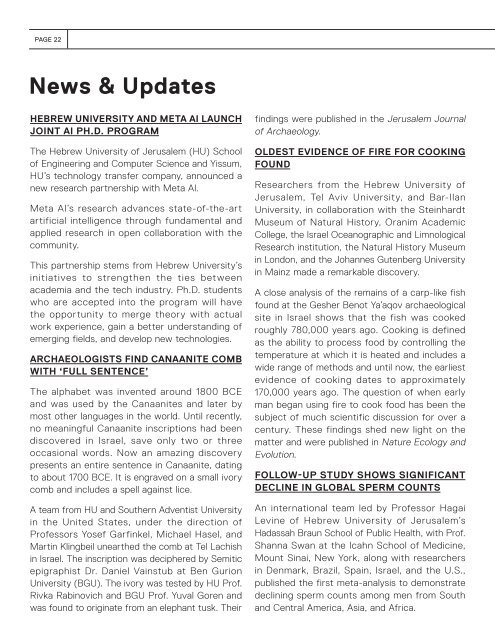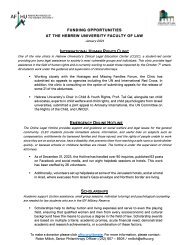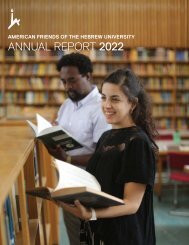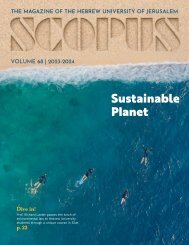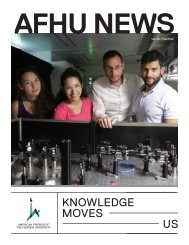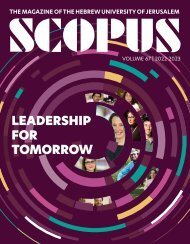You also want an ePaper? Increase the reach of your titles
YUMPU automatically turns print PDFs into web optimized ePapers that Google loves.
PAGE 22<br />
AMERICAN FRIENDS OF THE HEBREW UNIVERSITY<br />
<strong>AFHU</strong> NEWS VOL. 30 PAGE 23<br />
<strong>News</strong> & Updates<br />
HEBREW UNIVERSITY AND META AI LAUNCH<br />
JOINT AI PH.D. PROGRAM<br />
The Hebrew University of Jerusalem (HU) School<br />
of Engineering and Computer Science and Yissum,<br />
HU’s technology transfer company, announced a<br />
new research partnership with Meta AI.<br />
Meta AI’s research advances state-of-the-art<br />
artificial intelligence through fundamental and<br />
applied research in open collaboration with the<br />
community.<br />
This partnership stems from Hebrew University’s<br />
initiatives to strengthen the ties between<br />
academia and the tech industry. Ph.D. students<br />
who are accepted into the program will have<br />
the opportunity to merge theory with actual<br />
work experience, gain a better understanding of<br />
emerging fields, and develop new technologies.<br />
ARCHAEOLOGISTS FIND CANAANITE COMB<br />
WITH ‘FULL SENTENCE’<br />
The alphabet was invented around 1800 BCE<br />
and was used by the Canaanites and later by<br />
most other languages in the world. Until recently,<br />
no meaningful Canaanite inscriptions had been<br />
discovered in Israel, save only two or three<br />
occasional words. Now an amazing discovery<br />
presents an entire sentence in Canaanite, dating<br />
to about 1700 BCE. It is engraved on a small ivory<br />
comb and includes a spell against lice.<br />
A team from HU and Southern Adventist University<br />
in the United States, under the direction of<br />
Professors Yosef Garfinkel, Michael Hasel, and<br />
Martin Klingbeil unearthed the comb at Tel Lachish<br />
in Israel. The inscription was deciphered by Semitic<br />
epigraphist Dr. Daniel Vainstub at Ben Gurion<br />
University (BGU). The ivory was tested by HU Prof.<br />
Rivka Rabinovich and BGU Prof. Yuval Goren and<br />
was found to originate from an elephant tusk. Their<br />
findings were published in the Jerusalem Journal<br />
of Archaeology.<br />
OLDEST EVIDENCE OF FIRE FOR COOKING<br />
FOUND<br />
Researchers from the Hebrew University of<br />
Jerusalem, Tel Aviv University, and Bar-Ilan<br />
University, in collaboration with the Steinhardt<br />
Museum of Natural History, Oranim Academic<br />
College, the Israel Oceanographic and Limnological<br />
Research institution, the Natural History Museum<br />
in London, and the Johannes Gutenberg University<br />
in Mainz made a remarkable discovery.<br />
A close analysis of the remains of a carp-like fish<br />
found at the Gesher Benot Ya’aqov archaeological<br />
site in Israel shows that the fish was cooked<br />
roughly 780,000 years ago. Cooking is defined<br />
as the ability to process food by controlling the<br />
temperature at which it is heated and includes a<br />
wide range of methods and until now, the earliest<br />
evidence of cooking dates to approximately<br />
170,000 years ago. The question of when early<br />
man began using fire to cook food has been the<br />
subject of much scientific discussion for over a<br />
century. These findings shed new light on the<br />
matter and were published in Nature Ecology and<br />
Evolution.<br />
FOLLOW-UP STUDY SHOWS SIGNIFICANT<br />
DECLINE IN GLOBAL SPERM COUNTS<br />
An international team led by Professor Hagai<br />
Levine of Hebrew University of Jerusalem’s<br />
Hadassah Braun School of Public Health, with Prof.<br />
Shanna Swan at the Icahn School of Medicine,<br />
Mount Sinai, New York, along with researchers<br />
in Denmark, Brazil, Spain, Israel, and the U.S.,<br />
published the first meta-analysis to demonstrate<br />
declining sperm counts among men from South<br />
and Central America, Asia, and Africa.<br />
Alarmingly, this study also shows that the decline<br />
in sperm counts in North America, Europe, and<br />
Australia—reported by this team in 2017—has<br />
continued and even accelerated in the 21st<br />
century. Sperm count is not only an indicator of<br />
human fertility; it also is an indicator of men’s<br />
health, with low levels being associated with<br />
an increased risk of chronic disease, testicular<br />
cancer, and a decreased lifespan. The authors<br />
say the decline reflects a global crisis related to<br />
our modern environment and lifestyle, with broad<br />
implications for the survival of the human species.<br />
BIONIC TECHNOLOGY LEADS TO<br />
BREAKTHROUGH IN ANTIBIOTIC SAFETY<br />
Antibiotic resistance is a growing public health<br />
concern with global implications. Antibioticresistant<br />
infections affect over 2.8 million<br />
individuals each year in the United States alone,<br />
resulting in more than 35,000 annual deaths. New<br />
resistance mechanisms constantly emerge and<br />
spread globally, threatening our ability to treat<br />
common infectious diseases, such as pneumonia,<br />
tuberculosis, and sepsis.<br />
Gentamicin is a commonly used antibiotic,<br />
considered an essential medicine by the World<br />
Health Organization (WHO). Antibiotics of this kind<br />
(aminoglycosides) cause kidney damage in up to<br />
25% of hospitalized patients using the medicine.<br />
This is a major problem for more than 37 million<br />
Americans estimated to suffer from chronic kidney<br />
disease, according to the Centers for Disease<br />
Control (CDC). In fact, the American Federal Drug<br />
Administration (FDA) considers the development<br />
of antibiotics for patients with chronic kidney<br />
disease to be a national priority.<br />
A group of researchers, led by Professor Yaakov<br />
Nahmias, Director of the Grass Center for<br />
Bioengineering at the Hebrew University of<br />
Jerusalem, and founder of the biotechnology startup<br />
Tissue Dynamics, found a new mechanism of<br />
antibiotics-induced kidney damage, never previously<br />
identified.“This is a dramatic demonstration<br />
that bionic technology, which blends sensors<br />
with human tissue, could rapidly propel drug<br />
development forward,” shared Nahmias, whose<br />
company Tissue Dynamics was recently selected<br />
as one of the top five organ-on-chip companies<br />
in the world.<br />
MEDIEVAL REMAINS REVEAL ASHKENAZI<br />
JEWS HAVE BECOME MORE GENETICALLY<br />
SIMILAR OVER TIME<br />
Excavating ancient DNA from teeth, an<br />
international group of scientists peered into the<br />
lives of a once-thriving medieval Ashkenazi Jewish<br />
community in Erfurt, Germany. The findings,<br />
shared recently in the journal Cell, show that the<br />
Erfurt Jewish community was more genetically<br />
diverse than modern-day Ashkenazi Jews.<br />
About half of Jews today are identified as<br />
Ashkenazi, meaning that they originate from Jews<br />
living in Central or Eastern Europe. The term was<br />
initially used to define a distinct cultural group of<br />
Jews who settled in the 10th century in Germany’s<br />
Rhineland. Despite much speculation, many<br />
gaps exist in our understanding of their origins<br />
and demographic upheavals during the second<br />
millennium.<br />
“Today, if you compare Ashkenazi Jews from<br />
the United States and Israel, they’re very similar<br />
genetically, almost like the same population<br />
regardless of where they live,” shared geneticist<br />
and co-author HU Professor Shai Carmi. But unlike<br />
today’s genetic uniformity, it turns out that the<br />
community was more diverse 600 years ago.<br />
Digging into the ancient DNA of 33 Ashkenazi Jews<br />
from medieval Erfurt, the team discovered that the<br />
community can be categorized into what seems<br />
like two groups. One relates more to individuals<br />
from Middle Eastern populations and the other to<br />
European populations, possibly including migrants<br />
to Erfurt from the East. The findings suggest that<br />
there were at least two genetically distinct groups


